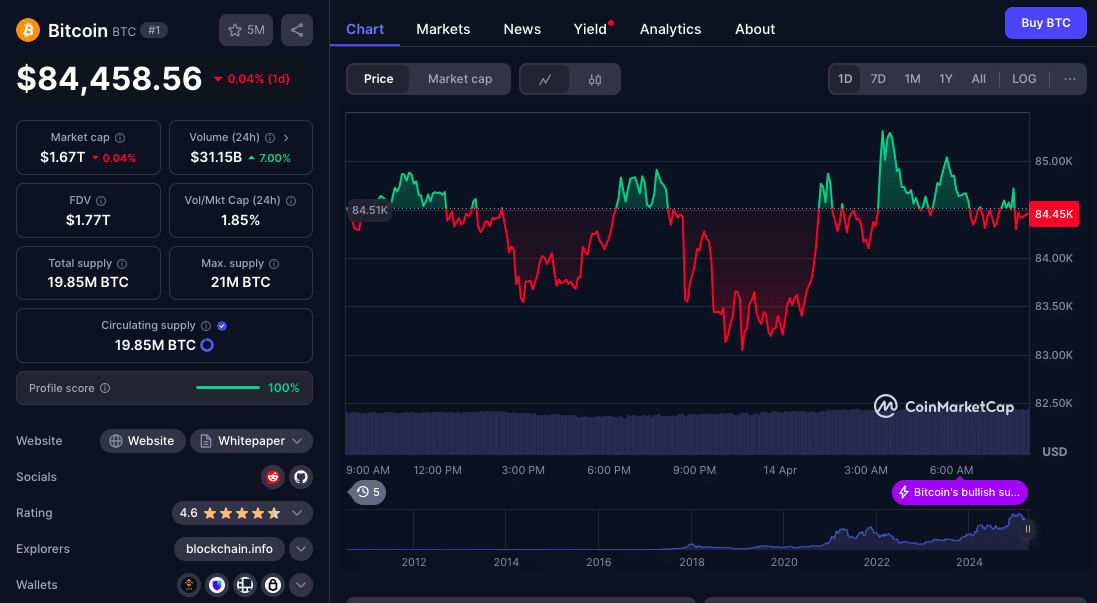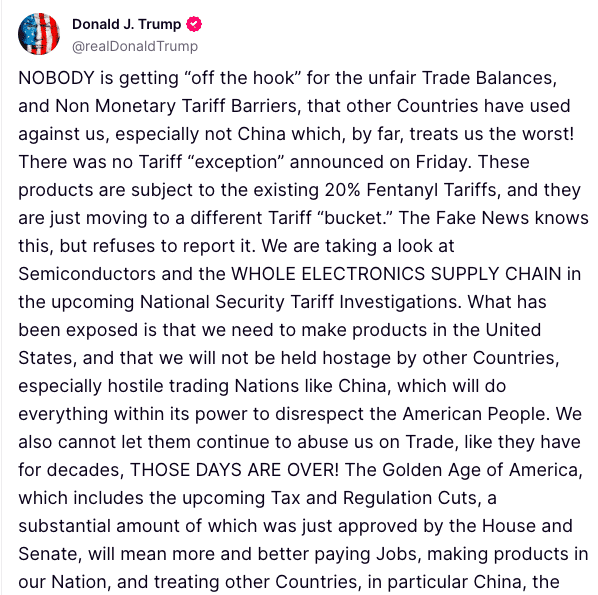Bitcoin dropped 2% on Sunday to $83,482 as the crypto market reacted to the weekend’s confusion surrounding President Donald Trump’s U.S.-China tariffs comments. The conflicting Trumps tariffs news reportedly erased part of Bitcoin’s weekly gains and has traders reassessing inflation and the Fed’s next move.
Trumps Tariffs News Weekend Messaging Muddies Market
The market started to shake with a series of conflicting posts from President Trump on Truth Social where he seemed to walk back a previously announced 90 day pause on certain tariffs. Trump clarified Sunday evening that while some electronics like smartphones and laptops were “temporarily excluded” from the new 10% reciprocal tariff plan, those same items would still be subject to a separate 20% national security focused tariff.
“There was no tariff ‘exception’ announced on Friday,” Trump wrote. “NOBODY is getting ‘off the hook’ for the unfair trade balances… especially not China, which treats us the worst by far!”
These Trumps tariffs news messages spooked traders and reignited fears of prolonged trade tensions and inflationary spillovers. Commerce Secretary Howard Lutnick added to the uncertainty saying additional sector specific tariffs on Chinese electronics could be rolled out in the next 2 months.
Equities Bounce While Crypto Tanks
While equities seemed to shrug off the geopolitical tension, with Nasdaq 100 futures up over 1% and S&P 500 futures up 0.7%, crypto assets were a different story. Ethereum fell below $1,600, and altcoins like Solana and Avalanche were mixed.
Some experts project that crypto markets are hypersensitive to macroeconomic ambiguity, unlike equities, digital assets don’t have a strong inflation hedge narrative right now. Tariff induced inflation risks are putting downward pressure on crypto valuations.
The difference in reaction between traditional markets and crypto assets shows how fragile investor sentiment is in the digital asset space especially after months of volatility tied to regulatory uncertainty and ETF inflow stagnation.
Hawkish Fed Outlook
The crypto sell-off comes just before the Fed’s next meeting in May. Traders had previously priced in an emergency rate cut due to soft inflation data. But the Trump administration’s tariff switch has now brought back expectations of longer term inflation. Speaking with sources at Decrypt, Darren Chu, consulting analyst at BRN, said,
“Expectation has been dampened for an emergency rate cut before the May Fed meeting (and the June Fed meeting) with medium term inflationary effects from the Trump administration tariffs now expected to keep Powell from cutting before June.”
A higher for longer interest rate environment is bad for speculative assets and especially for cryptocurrencies that are sensitive to liquidity and investor risk appetite. The current market is similar to previous cycles where Fed hawkishness led to sharp corrections in digital assets.
Technical Pressure Builds on Bitcoin
Analysts are watching the $81,000 level as the key to Bitcoin’s near-term direction. A break below this could trigger a wave of liquidations in leveraged positions and increase volatility.
According to expert speculations, Bitcoin’s short-term technicals are shaky, If we break $81K, it opens up to a much deeper correction, maybe to $76,000.
The selloff also shows the growing correlation between crypto and global macro, with digital assets mirroring geopolitical risk and central bank policy. At press time, Bitcoin currently stands at $84,458.

Institutional Flows Show Signs of Cooling
Adding to the bearishness, Farside Investors data shows U.S.-listed Bitcoin ETFs had net outflows of $92 million on Friday, the worst daily outflow since early March. This reverses the net inflow trend that had stabilized prices last week after the inflation data.
ETF flows are a real-time indicator of institutional sentiment, when flows turn negative, it means even long-term allocators are hitting pause on their crypto exposure.
The uncertainty around the tariff regime, combined with fading hopes for a dovish Fed pivot, will keep institutions on the sidelines for the next few weeks unless new catalysts emerge.
Conclusion: A Fragile Balance Between Policy and Market Trust
The weekend’s price action shows the market is getting more vulnerable, where political rhetoric can send uncertainty through trading desks globally. With Trump’s tariffs news ambiguity once again highlighting the intersection of trade policy and asset prices, investors are left wondering what’s next.
As the Fed gets closer to its next decision and inflation forecasts are revised higher, Bitcoin may struggle to find support unless macro policy stability is restored. Until then, volatility will be the market’s best friend.
FAQs
Why did Bitcoin drop this weekend?
Bitcoin fell 2% due to mixed signals from Trumps tariffs news on Chinese goods, inflation and tighter Fed policy.
What did Trump say about tariffs?
Trump said some electronics are temporarily excluded from new tariffs but will still be taxed under a separate 20% national security levy.
How did other markets react?
Equities are holding up, and Nasdaq and S&P futures are up. Crypto went down.
Will this impact the Fed’s rate decision?
Tariff inflation fears will delay the rate cut and keep policy tighter for longer.
What to watch on Bitcoin?
$81,000 support. Below that and more equals downside.
Glossary
Reciprocal Tariff – A tariff to match what another country is charging.
Truth Social – A social media platform created by Donald Trump for public statements.
Leverage Liquidation – When a trader’s leveraged position gets forced sold when it falls below maintenance margin.
ETF (Exchange-Traded Fund) – A fund traded on stock exchanges that holds assets like Bitcoin.
Inflation Hedge – An investment that will retain or increase value during inflation.




















































































































